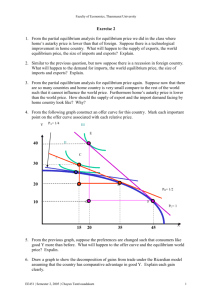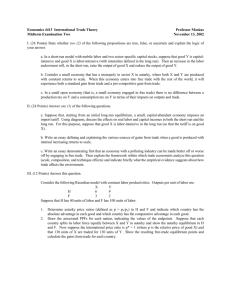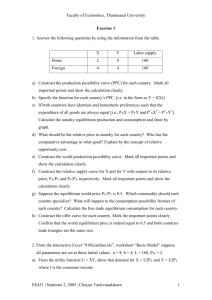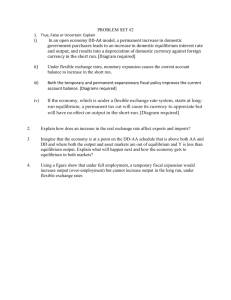set4
advertisement
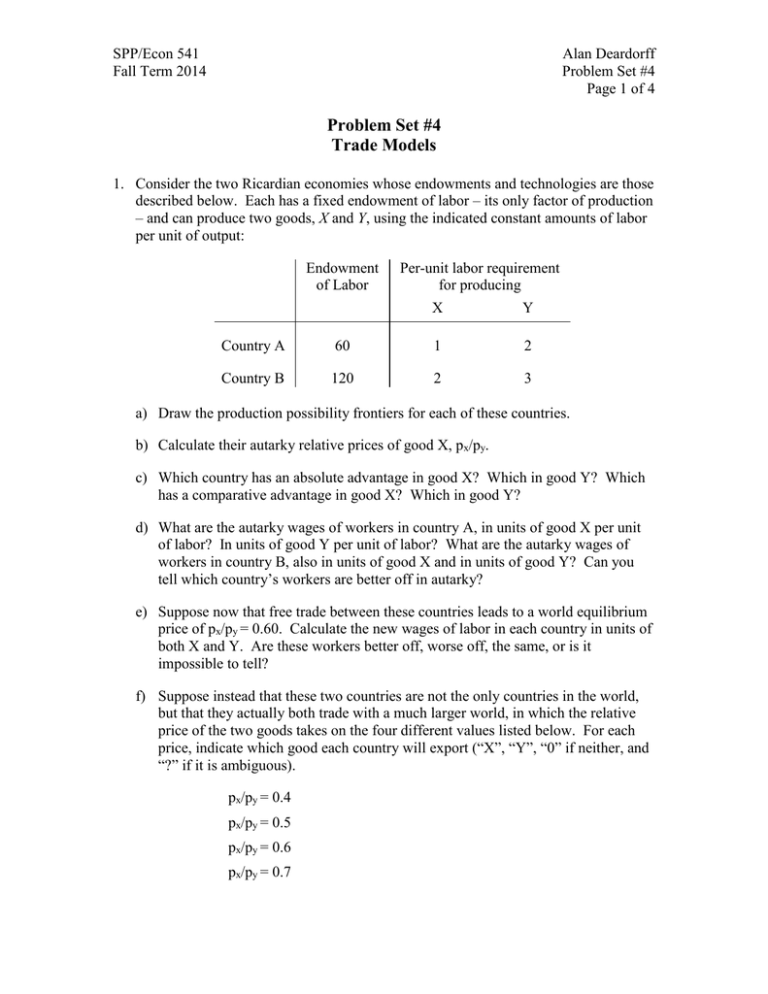
SPP/Econ 541 Fall Term 2014 Alan Deardorff Problem Set #4 Page 1 of 4 Problem Set #4 Trade Models 1. Consider the two Ricardian economies whose endowments and technologies are those described below. Each has a fixed endowment of labor – its only factor of production – and can produce two goods, X and Y, using the indicated constant amounts of labor per unit of output: Endowment of Labor Per-unit labor requirement for producing X Y Country A 60 1 2 Country B 120 2 3 a) Draw the production possibility frontiers for each of these countries. b) Calculate their autarky relative prices of good X, px/py. c) Which country has an absolute advantage in good X? Which in good Y? Which has a comparative advantage in good X? Which in good Y? d) What are the autarky wages of workers in country A, in units of good X per unit of labor? In units of good Y per unit of labor? What are the autarky wages of workers in country B, also in units of good X and in units of good Y? Can you tell which country’s workers are better off in autarky? e) Suppose now that free trade between these countries leads to a world equilibrium price of px/py = 0.60. Calculate the new wages of labor in each country in units of both X and Y. Are these workers better off, worse off, the same, or is it impossible to tell? f) Suppose instead that these two countries are not the only countries in the world, but that they actually both trade with a much larger world, in which the relative price of the two goods takes on the four different values listed below. For each price, indicate which good each country will export (“X”, “Y”, “0” if neither, and “?” if it is ambiguous). px/py = 0.4 px/py = 0.5 px/py = 0.6 px/py = 0.7 SPP/Econ 541 Fall Term 2014 Alan Deardorff Problem Set #4 Page 2 of 4 2. Using a Ricardian Model in which France and Britain have comparative advantages in croissants and crumpets respectively, work out the effects in both countries on the world relative price of croissants, and also on real wages in both countries, of the following changes (one at a time). Assume that in the initial equilibrium, both countries are completely specialized. a) The labor supply in France expands. b) The British technology for producing croissants improves, but not enough to reverse comparative advantage. c) The French technology for producing croissants improves. 3. All of the following statements refer to the standard Heckscher-Ohlin Model, with 2 factors (labor and land), 2 goods, and 2 countries. There are, as always in that model, constant returns to scale. Answer briefly whether and why each of the statements is either true or false: a) If the price of labor falls relative to the price of land, then both industries will change to using more labor-intensive techniques of production. b) Considering a country where land earns more than labor, then if both factor endowments increase in the same proportion, the output of the land-intensive good will increase by more (in percentage terms) than the output of the laborintensive good. c) If the relative price of the labor-intensive good rises, then the wage of labor will rise in the labor-intensive sector and fall in the land-intensive sector. d) If both countries are relatively well endowed with land compared to labor, then the relative price of the land-intensive good will rise in both countries when they open to trade with (only) each other. e) With free trade, if both countries continue to produce both goods, then workers in the country with more land will be paid the same wage as workers in the other country. SPP/Econ 541 Fall Term 2014 Alan Deardorff Problem Set #4 Page 3 of 4 4. Using the Standard Trade Model in which the two goods are bananas and apricots, and the two countries are Moldova and Iceland with Iceland initially exporting bananas to Moldova, work out the effects of the following changes on i) the international relative price of bananas, and ii) the outputs of both goods in both countries. For some of these you may find that some answers are ambiguous, and you should say so, and explain why. a) A shift in consumer preferences in both countries in favor of apricots. b) A technological improvement that increases, for any given allocation of resources, the output of bananas in Iceland by 20%. c) Same as (b), but the technological improvement in producing bananas occurs in both countries. d) A prohibitive tariff (i.e., one that reduces imports to zero) levied by Moldova. 5. In the situation of Krugman, Obstfeld, and Melitz’s Figure 7-5 (p. 148), what will happen to the price on the world market if Thailand pursues each of the following policies? a) A permanent prohibition of watch imports into Thailand. b) A large tariff on watch imports that is left in place only until a new equilibrium is reached, and then removed. c) A permanent subsidy to watch production in Thailand equal to C0 - P2 . d) A temporary subsidy to watch production in Thailand equal to C0 - P2 , left in place only until a new equilibrium is reached, and then removed. 6. Using the equations of the monopolistic competition model in Krugman, Obstfeld, and Melitz’s Chapter 8 (see (8-6) p. 162 and (8-10) p. 163) and the requirement that profits be zero, a) Solve explicitly for the equilibrium number of firms and the equilibrium price. b) What is the effect on consumers in this model if the marginal cost of production, c, goes down? c) Show that if two identical countries both with market size S join into a single market with free trade, the number of firms in the world is reduced. d) Suppose that consumers become more sensitive to price differences across firms. How will this change the demand function faced by firms, and what will it do to the equilibrium number of firms and equilibrium price? Can you explain your answer? SPP/Econ 541 Fall Term 2014 Alan Deardorff Problem Set #4 Page 4 of 4 7. Consider a firm that is the only producer of a good in its domestic market and that has the marginal and average cost curves shown below. Demand in its domestic market is the linear demand curve shown, and the world price of the good is pW. a) If there are no barriers to exports or imports of this good, what will this firm do? b) If imports are prohibited but the firm can export freely, what will it do? c) If neither exports nor imports are permitted, what will it do?
